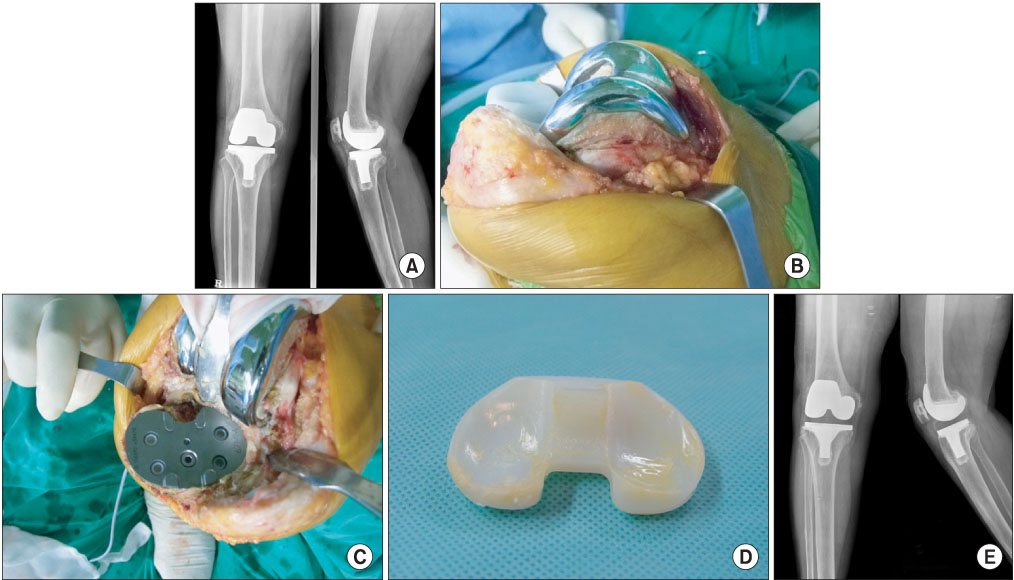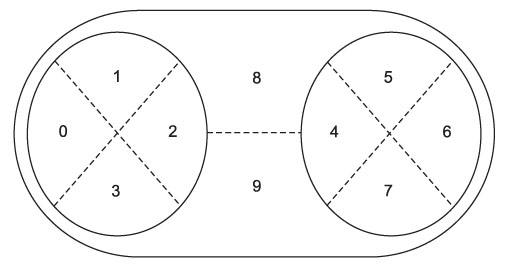J Korean Orthop Assoc.
2011 Apr;46(2):114-121.
Outcome of Isolated Tibial Polyethylene Insert Exchange after Total Knee Arthroplasty
- Affiliations
-
- 1Department of Orthopaedic Surgery, School of Medicine, Wonkwang University, Wonkwang Medical Science Research Center, Iksan, Korea. cch@wonkwang.ac.kr
Abstract
- PURPOSE
We investigated the short term outcomes of isolated tibial polyethylene insert exchange after revision total knee arthroplasty.
MATERIALS AND METHODS
We selected 18 cases from 17 patients among the 20 cases from 19 patients who took isolated tibial polyethylene insert exchange after mean 69 months-follow up of TKA, which was carried out from June 1991 to August 2003. Two cases were excluded on account of loss to follow-up. In all cases, isolated tibial polyethylene insert exchange was carried out from May 1998 to October 2008 in our institute and the mean follow-up period after operation was 48 (22-142) months. We evaluated the following clinical and radiologic aspects: range of motion, HSS score, average labor time, and BMI. Together, these factors were used in clinical evaluation while femorotibial angle and radiolucent line were used in radiologic evaluation.
RESULTS
The average range of motion was 110.6 degrees and HSS score was 86.9 in follow up period. The average femorotibial angle was valgus 5.3degrees. The average labor time was 9.7 hours and BMI was 25.9. Although radiolucent line was found in 4 cases, there were all confirmed to be non progressive lesion less than 2 mm. Survival rate was 100% in Kaplan-Meier survival analysis.
CONCLUSION
Selective isolated tibial polyethylene insert exchange can be the successful method for revision TKA in limited cases.
MeSH Terms
Figure
Reference
-
1. Kilgus DJ, Moreland JR, Finerman GA, Funahashi TT, Tipton JS. Catastrophic wear of tibial polyethylene inserts. Clin Orthop Relat Res. 1991. (273):223–231.
Article2. Pagnano MW, Hanssen AD, Lewallen DG, Stuart MJ. Flexion instability after primary posterior cruciate retaining total knee arthroplasty. Clin Orthop Relat Res. 1998. (356):39–46.
Article3. Griffin WL, Scott RD, Dalury DF, Mahoney OM, Chiavetta JB, Odum SM. Modular insert exchange in knee arthroplasty for treatment of wear and osteolysis. Clin Orthop Relat Res. 2007. 464:132–137.
Article4. Jensen CL, Petersen MM, Jensen KE, Therbo M, Schrøder HM. Outcome of isolated tibial polyethylene insert exchange after uncemented total knee arthroplasty: 27 patients followed for 8-71 months. Acta Orthop. 2006. 77:917–920.
Article5. Babis GC, Trousdale RT, Pagnano MW, Morrey BF. Poor outcomes of isolated tibial insert exchange and arthrolysis for the management of stiffness following total knee arthroplasty. J Bone Joint Surg Am. 2001. 83-A:1534–1536.
Article6. Babis GC, Trousdale RT, Morrey BF. The effectiveness of isolated tibial insert exchange in revision total knee arthroplasty. J Bone Joint Surg Am. 2002. 84-A:64–68.
Article7. Engh GA, Koralewicz LM, Pereles TR. Clinical results of modular polyethylene insert exchange with retention of total knee arthroplasty components. J Bone Joint Surg Am. 2000. 82:516–523.
Article8. Manaster BJ. Total knee arthroplasty: postoperative radiologic findings. AJR Am J Roentgenol. 1995. 165:899–904.
Article9. Ewald FC. The Knee Society total knee arthroplasty roentgenographic evaluation and scoring system. Clin Orthop Relat Res. 1989. (248):9–12.
Article10. Shin JY, Kho DH, Kim KH, Kim DH, Kim DH. Polyethylene wear between farming and non-farming patients after total knee arthroplasty. J Korean Knee Soc. 2007. 19:14–19.11. Insall JN, Dorr LD, Scott RD, Scott WN. Rationale of the Knee Society clinical rating system. Clin Orthop Relat Res. 1989. (248):13–14.
Article12. Hood RW, Wright TM, Burstein AH. Retrieval analysis of total knee prostheses: a method and its application to 48 total condylar prostheses. J Biomed Mater Res. 1983. 17:829–842.
Article13. Kaplan EL, Meier P. Nonparametric estimation from incomplete observations. J Am Stat Assoc. 1958. 53:457.
Article14. Willson SE, Munro ML, Sandwell JC, Ezzet KA, Colwell CW Jr. Isolated tibial polyethylene insert exchange outcomes after total knee arthroplasty. Clin Orthop Relat Res. 2010. 468:96–101.
Article15. Blunn GW, Joshi AB, Minns RJ, et al. Wear in retrieved condylar knee arthroplasties. A comparison of wear in different designs of 280 retrieved condylar knee prostheses. J Arthroplasty. 1997. 12:281–290.16. Heck DA, Clingman JK, Kettelkamp DG. Gross polyethylene failure in total knee arthroplasty. Orthopedics. 1992. 15:23–28.
Article17. Mintz L, Tsao AK, McCrae CR, Stulberg SD, Wright T. The arthroscopic evaluation and characteristics of severe polyethylene wear in total knee arthroplasty. Clin Orthop Relat Res. 1991. (273):215–222.
Article18. Bert JM, Reuben J, Kelly F, Gross M, Elting J. The incidence of modular tibial polyethylene insert exchange in total knee arthroplasty when polyethylene failure occurs. J Arthroplasty. 1998. 13:609–614.
Article19. Lavernia CJ, Sierra RJ, Hungerford DS, Krackow K. Activity level and wear in total knee arthroplasty: a study of autopsy retrieved specimens. J Arthroplasty. 2001. 16:446–453.20. United Nation Development Program (New York, US), Gender, work and time allocation ; Human development report. 2007. The Human Development Office (HDRO);342.
- Full Text Links
- Actions
-
Cited
- CITED
-
- Close
- Share
- Similar articles
-
- Dislocation of Tibial Insert after Fixed Bearing TKA using Minimal Invasive Surgery: A Case Report
- The Results of Revision Total Knee Replacement Arthroplasty
- Clinical Results of Unicompartmental Knee Arthroplasty
- Assessment of Failure Modes in Total Knee Replacement Arthroplasty
- Component Size Matched Extension Gap Osteotomy for TKRA: A New Concept in Knee Osteotomy for TKRA




